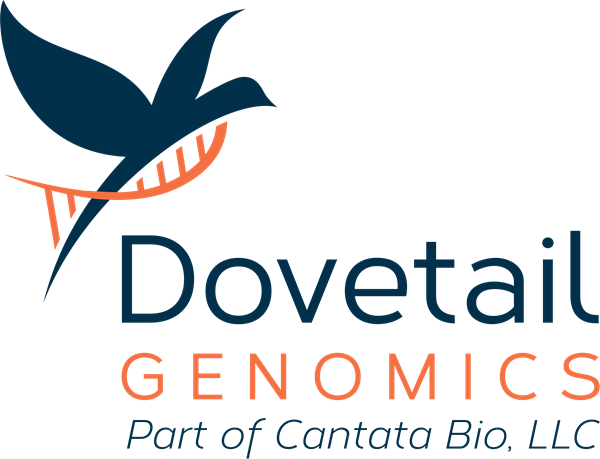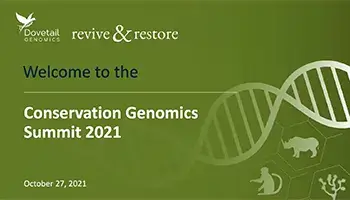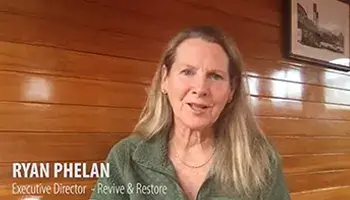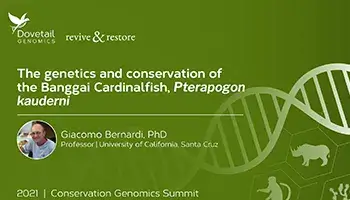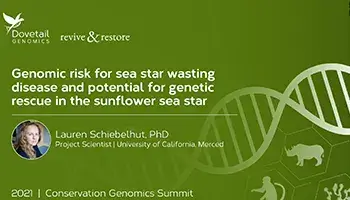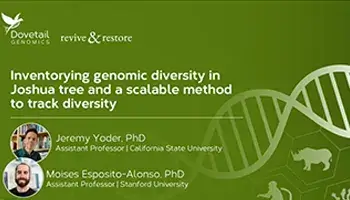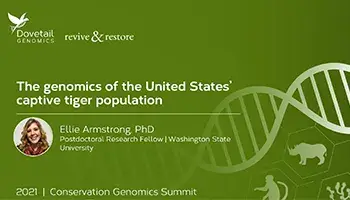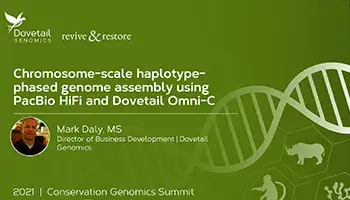Mark Daly
Dovetail Genomics
Dovetail Genomics® is the world leader in non-model organism de novo genome assembly. A high-quality reference genome is a critical tool necessary to understand the biology of any organism. With a reference genome in hand, the conservation biologist is properly equipped to undertake population genetics studies that can then be used to understand the genetics of at-risk species.
Ryan Phelan
Executive Director, Revive & Restore
Revive & Restore is the leading wildlife conservation organization incorporating biotechnologies into standard conservation practice. Through their competitive Wild Genomes program, Revive & Restore provides biobanking and genomic sequencing resources to field scientists and wildlife managers working to protect biodiversity.
Giacomo Bernard, Professor of Biology
University of California Santa Cruz, Ecology and Evolutionary Biology Department
Banggai Cardinalfish are a spectacular coral reef species that lives in a very small area of the Banggai Archipelago, near Sulawesi, Indonesia.
The species was first described in the 1930’s but was essentially forgotten until its rediscovery in the mid 1990’s. Since then, the fish has become an extremely popular aquarium fish, which started a mad rush to collect as many individuals as possible, transforming it rapidly from an unknown species to an endangered one. The life history of the Banggai Cardinalfish is very unusual. It is a mouthbrooder, where the male guards eggs in its mouth (like all cardinal fishes). In this species, however, the male keeps the babies in its mouth until they are ready to recruit on the adjacent habitat. This results in very low dispersal capabilities and unique genetic signatures. While local populations are genetically very well adapted to their environment, they are also particularly vulnerable to collection and local extinction.
Genomic risk for sea star wasting disease and potential for genetic rescue in the sunflower sea star
Lauren Schiebelhut, PhD
University of California, Merced
The increased frequency of marine heat waves and mass mortality events threaten population stability of ecologically important marine species and can limit the natural capacity of populations to respond to ratcheting stressors. Starting in 2013, the sunflower sea star (Pycnopodia helianthoides) experienced 88–100% mortality from all but the northernmost portion of its range due to sea star wasting (SSW) disease and elevated water temperatures. Once abundant and widespread from Baja California Mexico to Alaska USA, the recent sharp decline led to the species being listed at Critically Endangered by the IUCN in early 2021. These dramatic declines and their community consequences have spurred the need for quick concerted actions to conserve the species and collect the information necessary to inform potential conservation interventions. With Revive & Restore, we are working to discover genomic variants associated with vulnerability to wasting and temperature stress. We aim to develop a target capture set to rapidly and affordably screen Pycnopodia for candidate and neutral molecular markers of interest. We use a multipronged approach to identify candidate loci. Our findings will be used to generate the genomic insights needed to help inform conservation decisions and increase success along two conservation trajectories: (1) captive breeding for potential out-planting and (2) assessing wild populations for potential translocation and other conservation actions.
Jeremy B. Yoder, Assistant Professor, California State University
Moises Exposito-Alonso Staff Associate and Assistant Professor (by courtesy) of Biology, Carnegie Institution for Science and Stanford
Joshua tree, an ecological keystone of the Mojave Desert, is expected to see dramatic losses in habitat under projected climate change. The trees cannot migrate to track suitable climates, but they encounter a range of extreme heat and drought across their existing range, and populations may harbor genetic variation to support adaptation in place and assisted gene flow. Finding genetic variants that predict Joshua tree adaptation to particular climates could help to identify populations with adaptive capacity and prioritize them for protection, and could bolster restoration of Joshua tree populations by matching seed sources to projected future climates. We are conducting whole-genome resequencing of 300 Joshua trees sampled across the species’ range, to produce first large-scale sequencing of a keystone desert species. This will likely enable discovery of new genes related to the evolution of extremophile plants, allow us to map genetic variants for climate adaptation, and predict climate change resilience of extant Joshua tree populations to better target conservation efforts. The scope and scale of this work will, we hope, serve as a model for genetically-informed desert species conservation.
More species than ever before are at risk of extinction due to anthropogenic habitat loss and climate change. But even species that are not threatened have seen reductions in their populations and geographic ranges, likely impacting their genetic diversity. Although preserving genetic diversity is a key conservation target to maintain the adaptability of species, we lack predictive tools and global estimates of genetic diversity loss across ecosystems. By bridging biodiversity and population genetics theories, we introduce the first mathematical framework to understand the loss of naturally occurring DNA mutations within a species—what we call genetic diversity extinction. Analyzing genome-wide variation data of 10,126 geo-tagged individuals from 19 plant and animal species, we show that genome-wide diversity follows a power law with geographic area, which can predict genetic diversity decay in simulated spatial extinctions. Given pre-21st century values of ecosystem transformations, we estimate that over 10% of genetic diversity may be extinct, already surpassing the United Nations targets for genetic preservation. These estimated losses could rapidly increase with advancing climate change and habitat destruction, highlighting the need for new fore
Charles Yakov Feigin, PhD
Princeton University; Honorary Fellow, The University of Melbourne
The endangered eastern quoll (Dasyurus viverrinus) is among the last marsupial mesopredators in Australia. With the extinction of the last mainland populations in the late 20th century, this species is now restricted to the island of Tasmania, at the far southern end of its historical range. An exciting effort is underway to reintroduce this species to mainland Australia, but the absence of genomic resources for the eastern quoll hinders its effective genetic management. Here, I will present the first genome assembly for the eastern quoll, generated by Dovetail Genomics and discuss how this new resource will empower our efforts to preserve the adaptive viability of this unique species.
Ellie Armstrong, PhD
Washington State University
In the United States, unregulated breeding of large carnivores has resulted in a captive tiger population composed of at least several thousand individuals. To uncover the history of this population, we sequenced over 150 individuals that have been rescued from breeding and entertainment facilities. We analyze this data with a novel, chromosome-level genome assembly for tigers to describe the population structure, relatedness, diversity, and genetic load of these individuals in the broader context of each of the 6, naturally occurring subspecies of extant tigers. These results provide insight into the possible consequences of mixing divergent populations or subspecies, which not only has implications for captive population management, but may also be important for populations where translocations, rewilding, or assisted migration could result in similar patterns.
Mark Daly, Director of Business Development
Dovetail Genomics
Genome assemblies are typically haploid, and do not reflect the true genetic content of a diploid genome. Chromosome-scale diploid assembly is now being provided by Dovetail<sup>®</sup>. Chromosome-scale haplotype-phased genome assemblies require two things – high SNP call accuracy in the PacBio data, and even and complete genome-wide SNP coverage in the proximity ligation data. We use a unique combination of HiFi (high SNP call accuracy) and non-biased, restriction enzyme-free Omni-C<sup>®</sup> proximity ligation (even SNP coverage, chromosome-scale) to build very high-quality diploid assemblies of non-model organisms. Several case studies will be presented across a variety of taxa.
